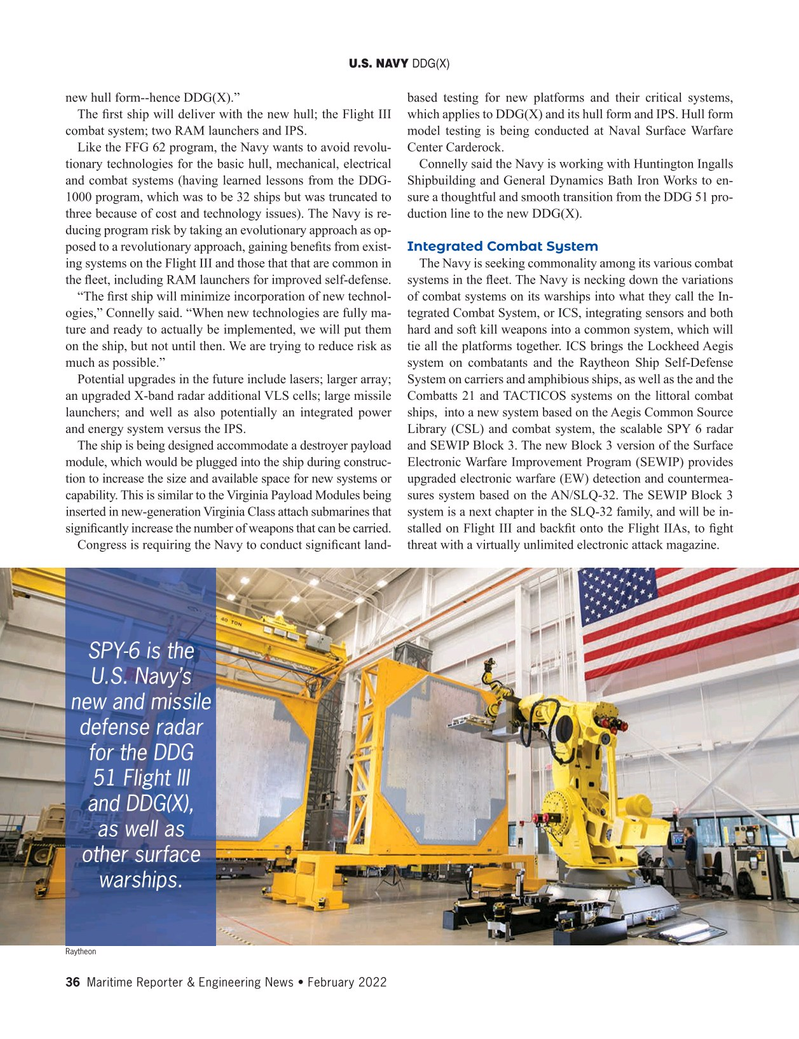
Page 36: of Maritime Reporter Magazine (February 2022)
Government Shipbuilding
Read this page in Pdf, Flash or Html5 edition of February 2022 Maritime Reporter Magazine
U.S. NAVY DDG(X) new hull form--hence DDG(X).” based testing for new platforms and their critical systems,
The ? rst ship will deliver with the new hull; the Flight III which applies to DDG(X) and its hull form and IPS. Hull form combat system; two RAM launchers and IPS. model testing is being conducted at Naval Surface Warfare
Like the FFG 62 program, the Navy wants to avoid revolu- Center Carderock.
tionary technologies for the basic hull, mechanical, electrical Connelly said the Navy is working with Huntington Ingalls and combat systems (having learned lessons from the DDG- Shipbuilding and General Dynamics Bath Iron Works to en- 1000 program, which was to be 32 ships but was truncated to sure a thoughtful and smooth transition from the DDG 51 pro- three because of cost and technology issues). The Navy is re- duction line to the new DDG(X).
ducing program risk by taking an evolutionary approach as op- posed to a revolutionary approach, gaining bene? ts from exist- Integrated Combat System ing systems on the Flight III and those that that are common in The Navy is seeking commonality among its various combat the ? eet, including RAM launchers for improved self-defense. systems in the ? eet. The Navy is necking down the variations “The ? rst ship will minimize incorporation of new technol- of combat systems on its warships into what they call the In- ogies,” Connelly said. “When new technologies are fully ma- tegrated Combat System, or ICS, integrating sensors and both ture and ready to actually be implemented, we will put them hard and soft kill weapons into a common system, which will on the ship, but not until then. We are trying to reduce risk as tie all the platforms together. ICS brings the Lockheed Aegis much as possible.” system on combatants and the Raytheon Ship Self-Defense
Potential upgrades in the future include lasers; larger array; System on carriers and amphibious ships, as well as the and the an upgraded X-band radar additional VLS cells; large missile Combatts 21 and TACTICOS systems on the littoral combat launchers; and well as also potentially an integrated power ships, into a new system based on the Aegis Common Source and energy system versus the IPS. Library (CSL) and combat system, the scalable SPY 6 radar
The ship is being designed accommodate a destroyer payload and SEWIP Block 3. The new Block 3 version of the Surface module, which would be plugged into the ship during construc- Electronic Warfare Improvement Program (SEWIP) provides tion to increase the size and available space for new systems or upgraded electronic warfare (EW) detection and countermea- capability. This is similar to the Virginia Payload Modules being sures system based on the AN/SLQ-32. The SEWIP Block 3 inserted in new-generation Virginia Class attach submarines that system is a next chapter in the SLQ-32 family, and will be in- signi? cantly increase the number of weapons that can be carried. stalled on Flight III and back? t onto the Flight IIAs, to ? ght
Congress is requiring the Navy to conduct signi? cant land- threat with a virtually unlimited electronic attack magazine.
SPY-6 is the
U.S. Navy’s new and missile defense radar for the DDG 51 Flight III and DDG(X), as well as other surface warships.
Raytheon 36 Maritime Reporter & Engineering News • February 2022
MR #2 (34-49).indd 36 2/4/2022 10:02:59 AM

 35
35

 37
37
